warning FORD E SERIES 2013 4.G User Guide
[x] Cancel search | Manufacturer: FORD, Model Year: 2013, Model line: E SERIES, Model: FORD E SERIES 2013 4.GPages: 416, PDF Size: 4.29 MB
Page 19 of 416
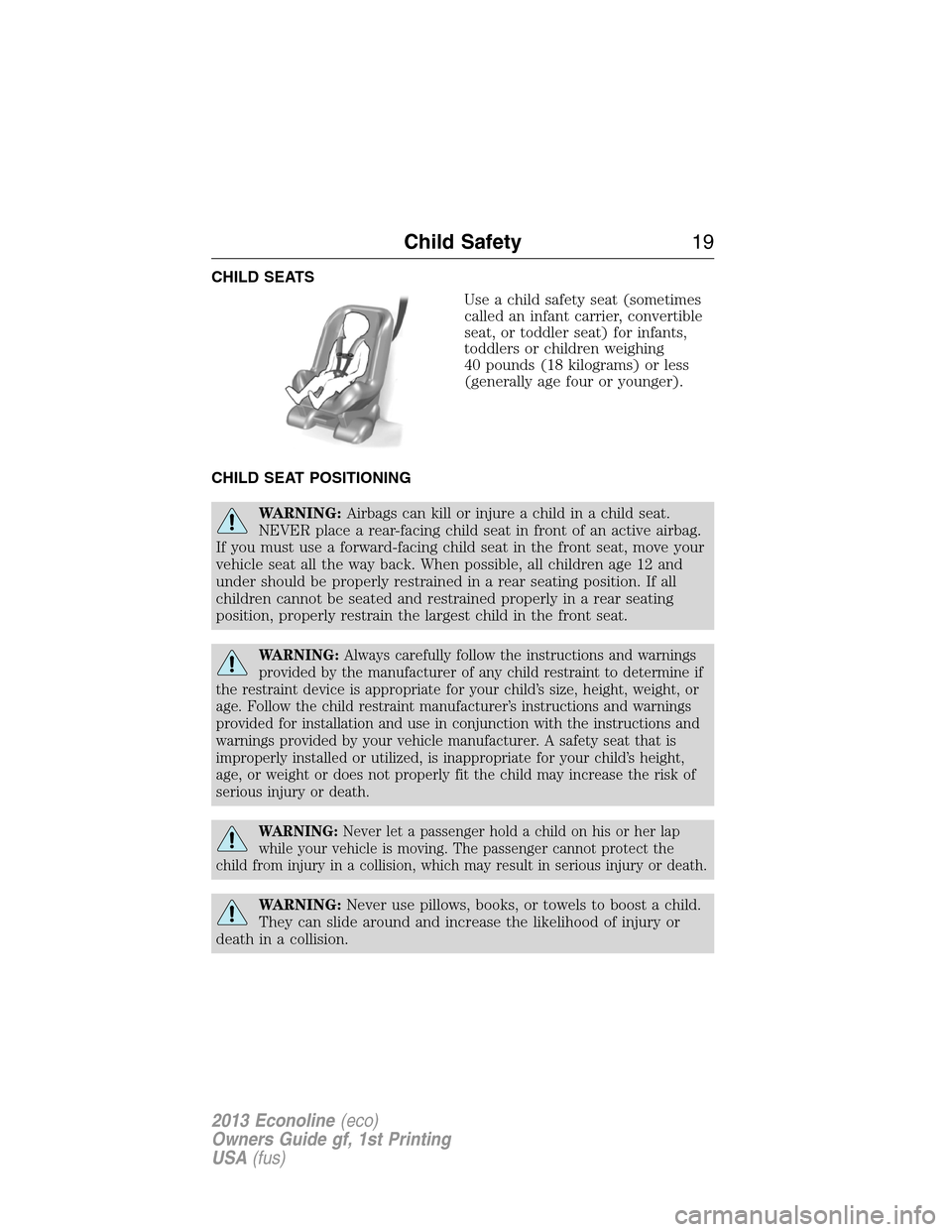
CHILD SEATS
Use a child safety seat (sometimes
called an infant carrier, convertible
seat, or toddler seat) for infants,
toddlers or children weighing
40 pounds (18 kilograms) or less
(generally age four or younger).
CHILD SEAT POSITIONING
WARNING:Airbags can kill or injure a child in a child seat.
NEVER place a rear-facing child seat in front of an active airbag.
If you must use a forward-facing child seat in the front seat, move your
vehicle seat all the way back. When possible, all children age 12 and
under should be properly restrained in a rear seating position. If all
children cannot be seated and restrained properly in a rear seating
position, properly restrain the largest child in the front seat.
WARNING:Always carefully follow the instructions and warnings
provided by the manufacturer of any child restraint to determine if
the restraint device is appropriate for your child’s size, height, weight, or
age. Follow the child restraint manufacturer’s instructions and warnings
provided for installation and use in conjunction with the instructions and
warnings provided by your vehicle manufacturer. A safety seat that is
improperly installed or utilized, is inappropriate for your child’s height,
age, or weight or does not properly fit the child may increase the risk of
serious injury or death.
WARNING:Never let a passenger hold a child on his or her lap
while your vehicle is moving. The passenger cannot protect the
child from injury in a collision, which may result in serious injury or death.
WARNING:Never use pillows, books, or towels to boost a child.
They can slide around and increase the likelihood of injury or
death in a collision.
Child Safety19
2013 Econoline(eco)
Owners Guide gf, 1st Printing
USA(fus)
Page 20 of 416
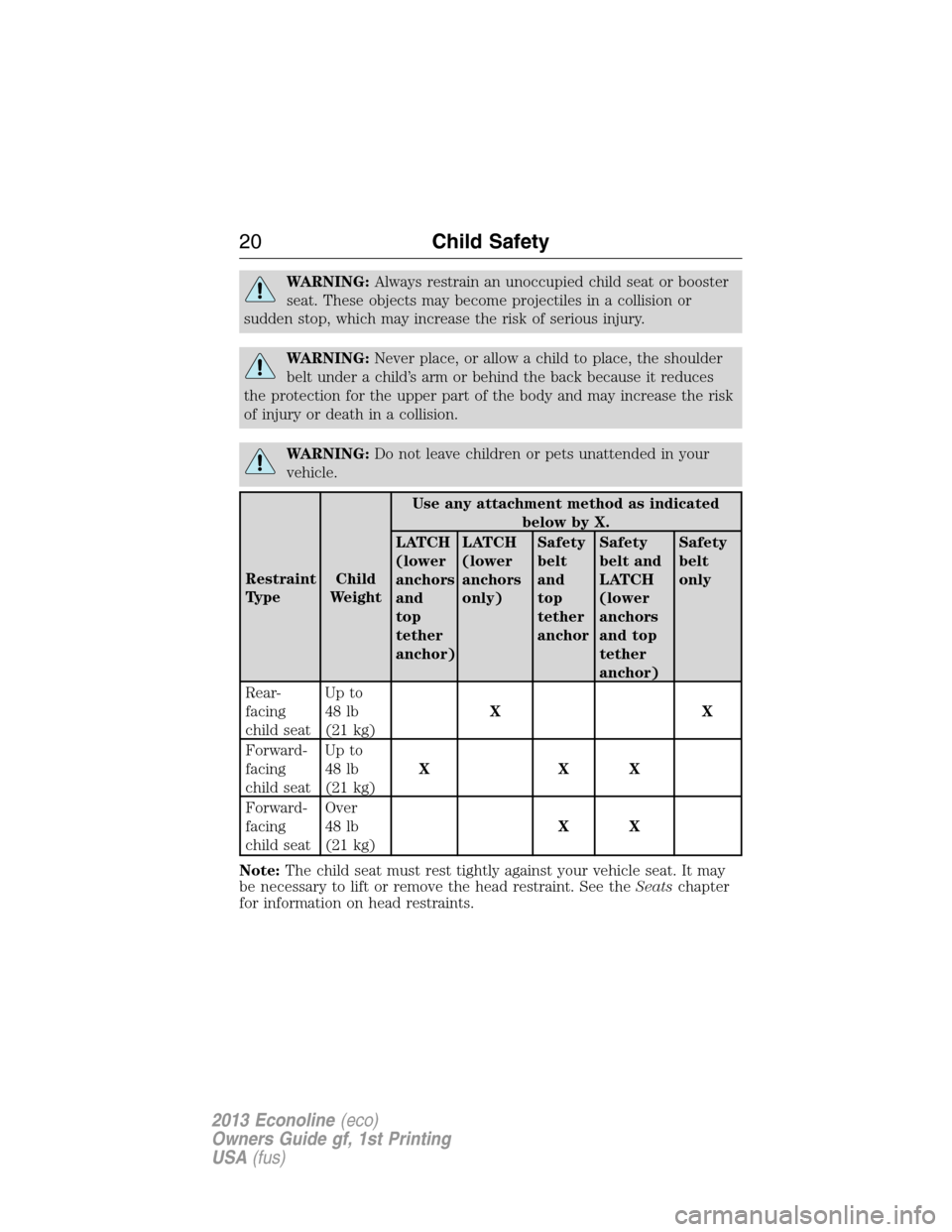
WARNING:Always restrain an unoccupied child seat or booster
seat. These objects may become projectiles in a collision or
sudden stop, which may increase the risk of serious injury.
WARNING:Never place, or allow a child to place, the shoulder
belt under a child’s arm or behind the back because it reduces
the protection for the upper part of the body and may increase the risk
of injury or death in a collision.
WARNING:Do not leave children or pets unattended in your
vehicle.
Restraint
TypeChild
WeightUse any attachment method as indicated
below by X.
LATCH
(lower
anchors
and
top
tether
anchor)LATCH
(lower
anchors
only)Safety
belt
and
top
tether
anchorSafety
belt and
LATCH
(lower
anchors
and top
tether
anchor)Safety
belt
only
Rear-
facing
child seatUp to
48 lb
(21 kg)XX
Forward-
facing
child seatUp to
48 lb
(21 kg)XXX
Forward-
facing
child seatOver
48 lb
(21 kg)XX
Note:The child seat must rest tightly against your vehicle seat. It may
be necessary to lift or remove the head restraint. See theSeatschapter
for information on head restraints.
20Child Safety
2013 Econoline(eco)
Owners Guide gf, 1st Printing
USA(fus)
Page 21 of 416
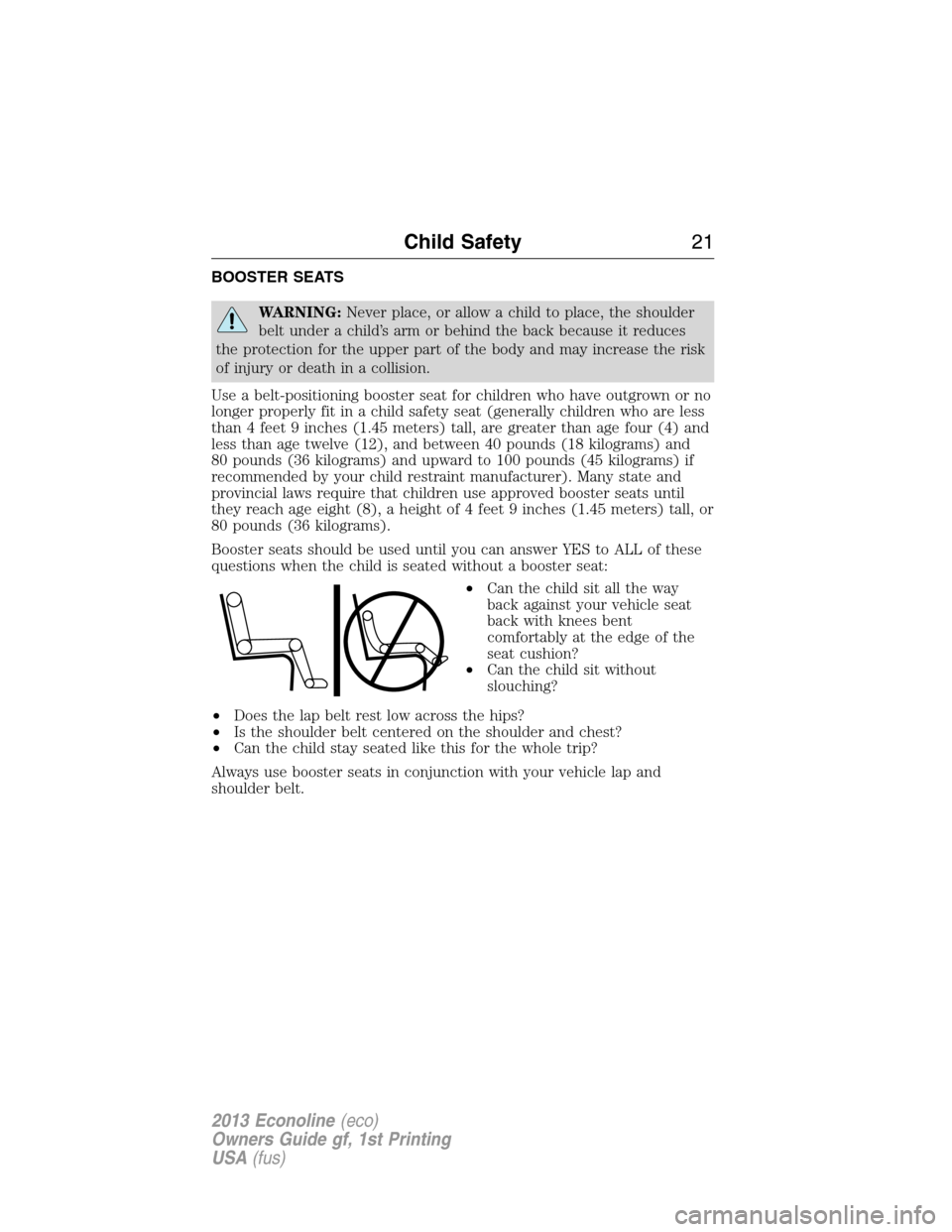
BOOSTER SEATS
WARNING:Never place, or allow a child to place, the shoulder
belt under a child’s arm or behind the back because it reduces
the protection for the upper part of the body and may increase the risk
of injury or death in a collision.
Use a belt-positioning booster seat for children who have outgrown or no
longer properly fit in a child safety seat (generally children who are less
than 4 feet 9 inches (1.45 meters) tall, are greater than age four (4) and
less than age twelve (12), and between 40 pounds (18 kilograms) and
80 pounds (36 kilograms) and upward to 100 pounds (45 kilograms) if
recommended by your child restraint manufacturer). Many state and
provincial laws require that children use approved booster seats until
they reach age eight (8), a height of 4 feet 9 inches (1.45 meters) tall, or
80 pounds (36 kilograms).
Booster seats should be used until you can answer YES to ALL of these
questions when the child is seated without a booster seat:
•Can the child sit all the way
back against your vehicle seat
back with knees bent
comfortably at the edge of the
seat cushion?
•Can the child sit without
slouching?
•Does the lap belt rest low across the hips?
•Is the shoulder belt centered on the shoulder and chest?
•Can the child stay seated like this for the whole trip?
Always use booster seats in conjunction with your vehicle lap and
shoulder belt.
Child Safety21
2013 Econoline(eco)
Owners Guide gf, 1st Printing
USA(fus)
Page 24 of 416
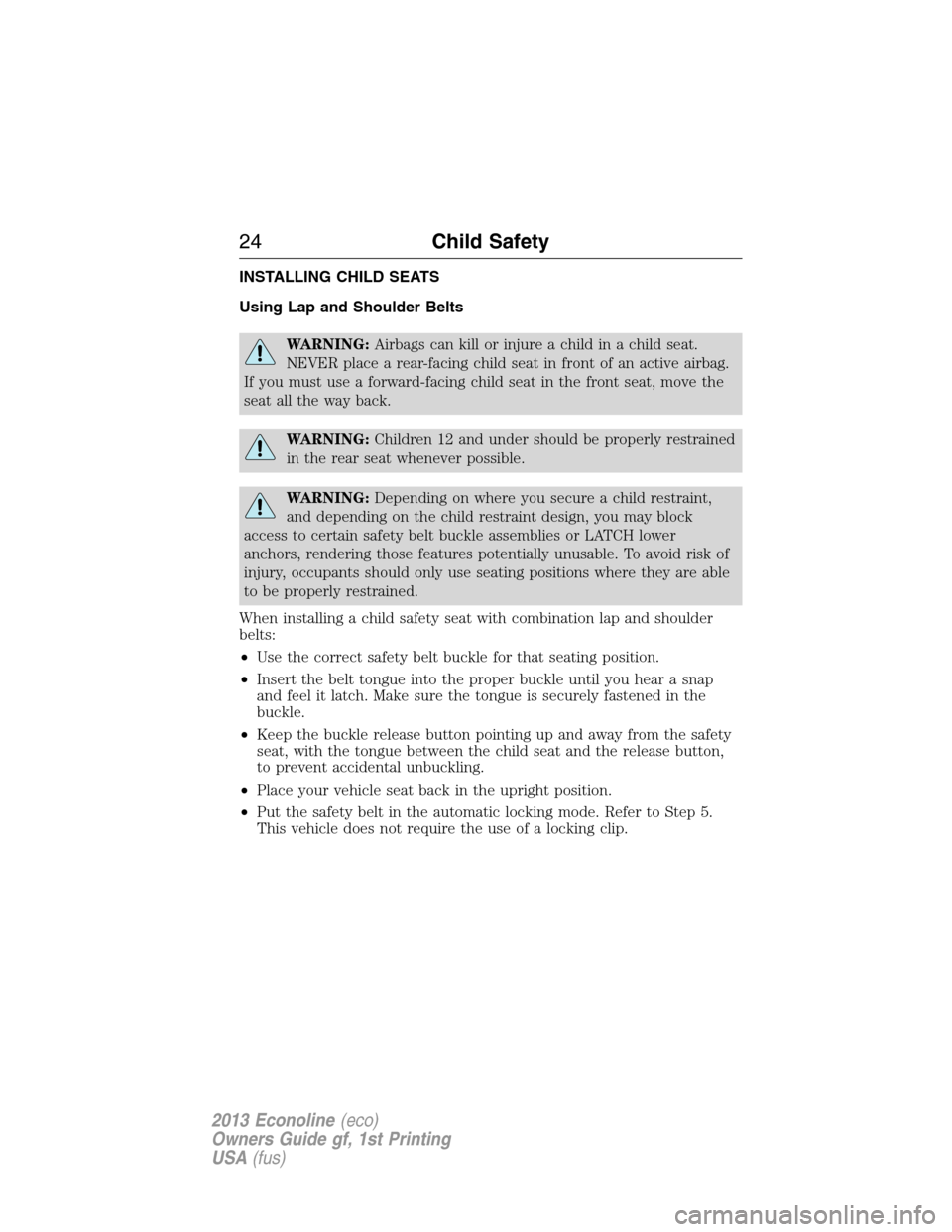
INSTALLING CHILD SEATS
Using Lap and Shoulder Belts
WARNING:Airbags can kill or injure a child in a child seat.
NEVER place a rear-facing child seat in front of an active airbag.
If you must use a forward-facing child seat in the front seat, move the
seat all the way back.
WARNING:Children 12 and under should be properly restrained
in the rear seat whenever possible.
WARNING:Depending on where you secure a child restraint,
and depending on the child restraint design, you may block
access to certain safety belt buckle assemblies or LATCH lower
anchors, rendering those features potentially unusable. To avoid risk of
injury, occupants should only use seating positions where they are able
to be properly restrained.
When installing a child safety seat with combination lap and shoulder
belts:
•Use the correct safety belt buckle for that seating position.
•Insert the belt tongue into the proper buckle until you hear a snap
and feel it latch. Make sure the tongue is securely fastened in the
buckle.
•Keep the buckle release button pointing up and away from the safety
seat, with the tongue between the child seat and the release button,
to prevent accidental unbuckling.
•Place your vehicle seat back in the upright position.
•Put the safety belt in the automatic locking mode. Refer to Step 5.
This vehicle does not require the use of a locking clip.
24Child Safety
2013 Econoline(eco)
Owners Guide gf, 1st Printing
USA(fus)
Page 27 of 416
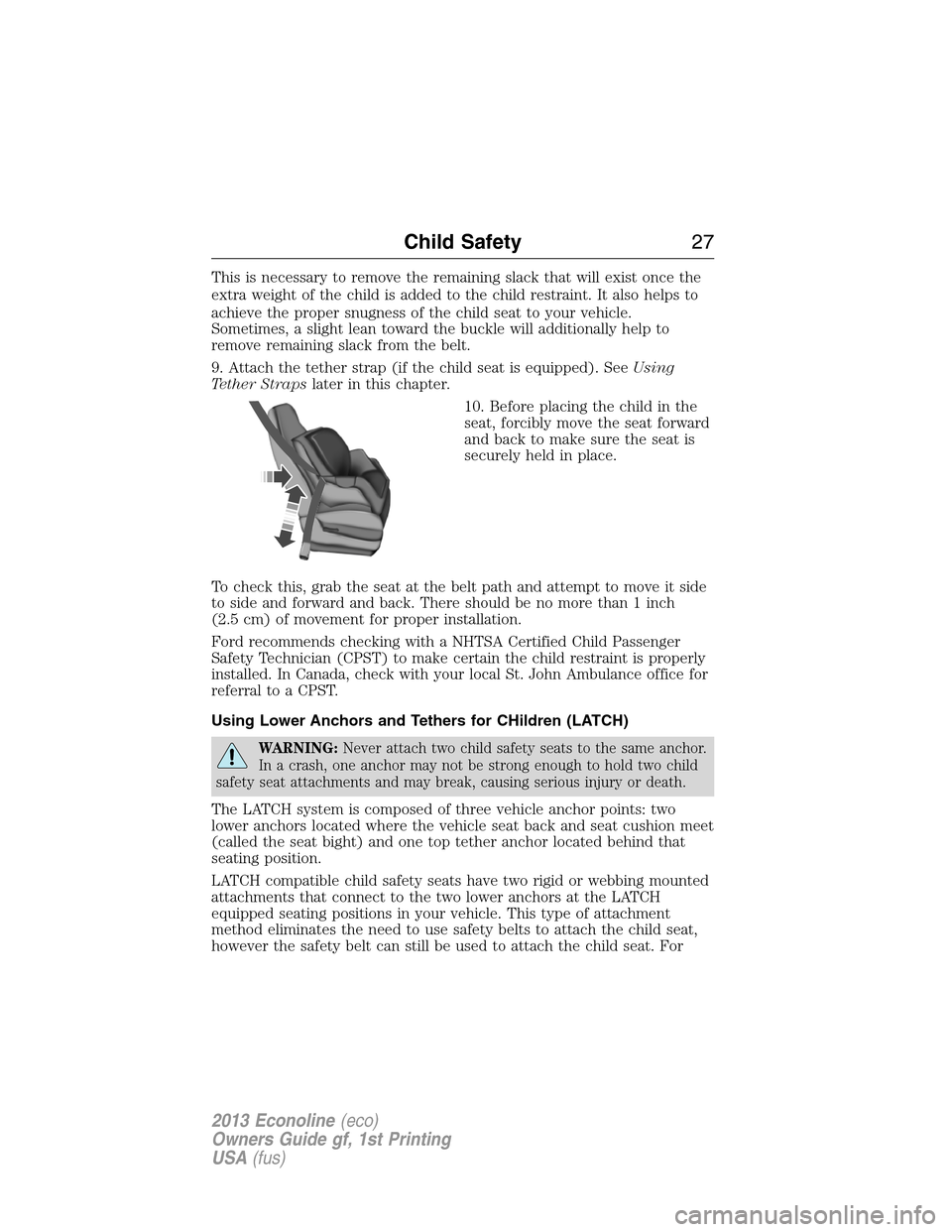
This is necessary to remove the remaining slack that will exist once the
extra weight of the child is added to the child restraint. It also helps to
achieve the proper snugness of the child seat to your vehicle.
Sometimes, a slight lean toward the buckle will additionally help to
remove remaining slack from the belt.
9. Attach the tether strap (if the child seat is equipped). SeeUsing
Tether Strapslater in this chapter.
10. Before placing the child in the
seat, forcibly move the seat forward
and back to make sure the seat is
securely held in place.
To check this, grab the seat at the belt path and attempt to move it side
to side and forward and back. There should be no more than 1 inch
(2.5 cm) of movement for proper installation.
Ford recommends checking with a NHTSA Certified Child Passenger
Safety Technician (CPST) to make certain the child restraint is properly
installed. In Canada, check with your local St. John Ambulance office for
referral to a CPST.
Using Lower Anchors and Tethers for CHildren (LATCH)
WARNING:Never attach two child safety seats to the same anchor.
In a crash, one anchor may not be strong enough to hold two child
safety seat attachments and may break, causing serious injury or death.
The LATCH system is composed of three vehicle anchor points: two
lower anchors located where the vehicle seat back and seat cushion meet
(called the seat bight) and one top tether anchor located behind that
seating position.
LATCH compatible child safety seats have two rigid or webbing mounted
attachments that connect to the two lower anchors at the LATCH
equipped seating positions in your vehicle. This type of attachment
method eliminates the need to use safety belts to attach the child seat,
however the safety belt can still be used to attach the child seat. For
Child Safety27
2013 Econoline(eco)
Owners Guide gf, 1st Printing
USA(fus)
Page 35 of 416
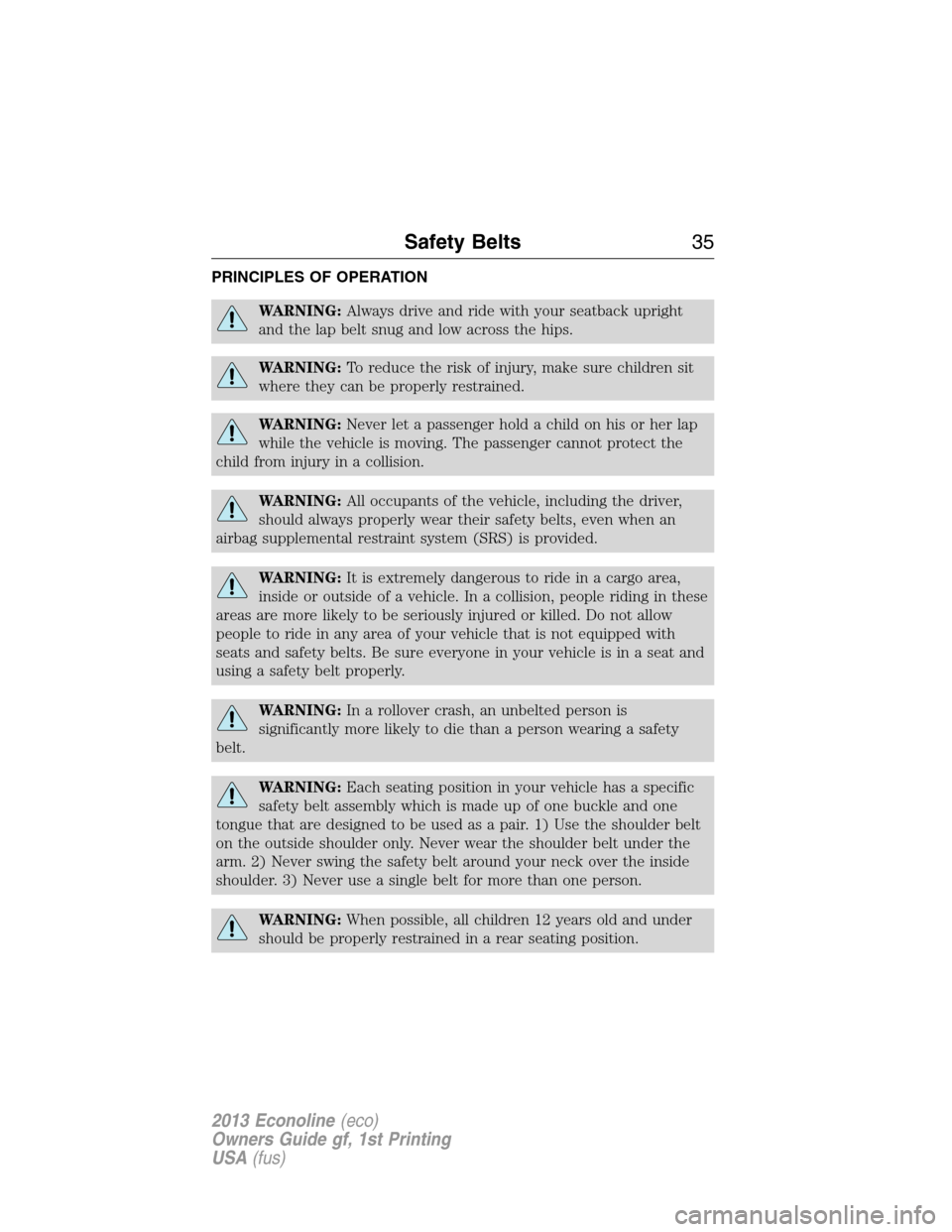
PRINCIPLES OF OPERATION
WARNING:Always drive and ride with your seatback upright
and the lap belt snug and low across the hips.
WARNING:To reduce the risk of injury, make sure children sit
where they can be properly restrained.
WARNING:Never let a passenger hold a child on his or her lap
while the vehicle is moving. The passenger cannot protect the
child from injury in a collision.
WARNING:All occupants of the vehicle, including the driver,
should always properly wear their safety belts, even when an
airbag supplemental restraint system (SRS) is provided.
WARNING:It is extremely dangerous to ride in a cargo area,
inside or outside of a vehicle. In a collision, people riding in these
areas are more likely to be seriously injured or killed. Do not allow
people to ride in any area of your vehicle that is not equipped with
seats and safety belts. Be sure everyone in your vehicle is in a seat and
using a safety belt properly.
WARNING:In a rollover crash, an unbelted person is
significantly more likely to die than a person wearing a safety
belt.
WARNING:Each seating position in your vehicle has a specific
safety belt assembly which is made up of one buckle and one
tongue that are designed to be used as a pair. 1) Use the shoulder belt
on the outside shoulder only. Never wear the shoulder belt under the
arm. 2) Never swing the safety belt around your neck over the inside
shoulder. 3) Never use a single belt for more than one person.
WARNING:When possible, all children 12 years old and under
should be properly restrained in a rear seating position.
Safety Belts35
2013 Econoline(eco)
Owners Guide gf, 1st Printing
USA(fus)
Page 36 of 416
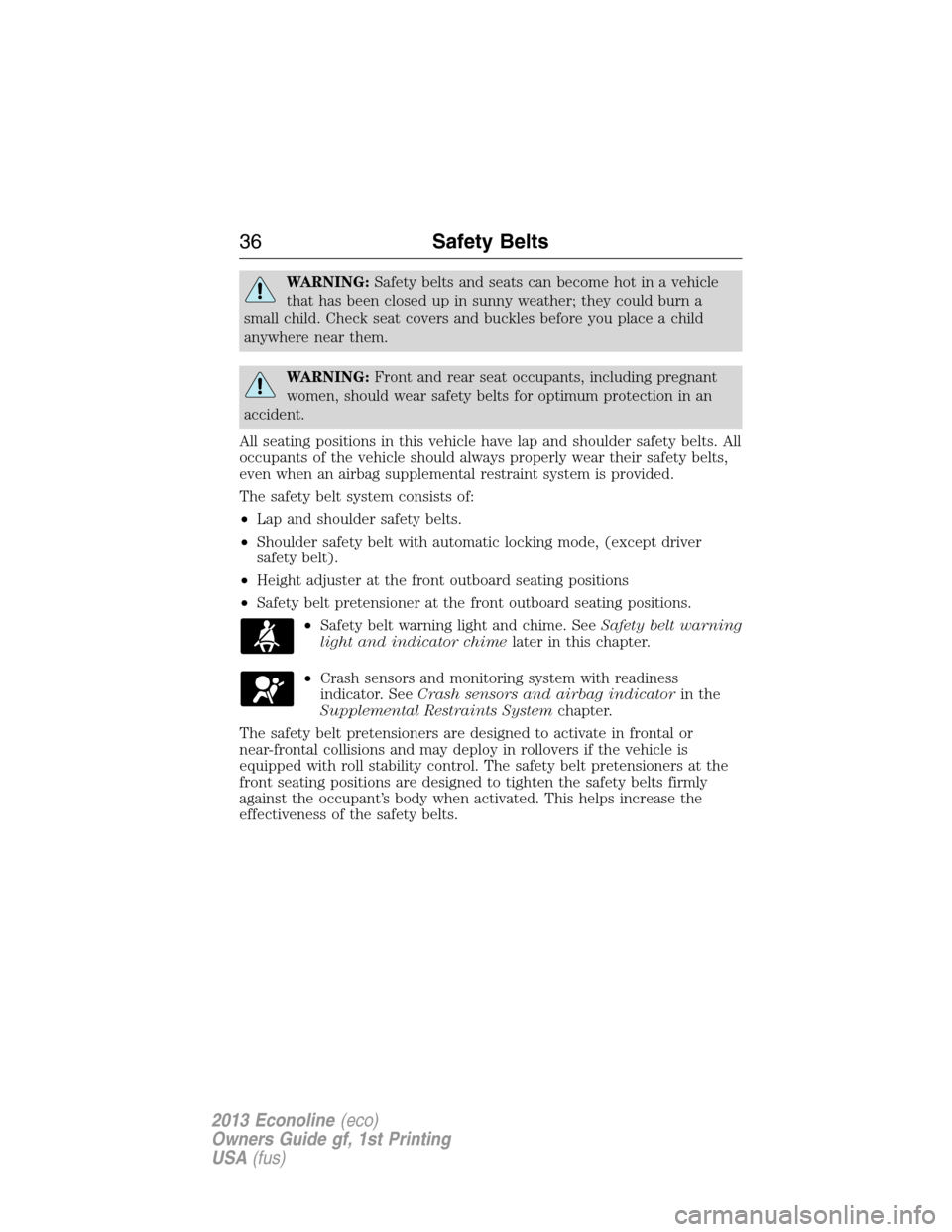
WARNING:Safety belts and seats can become hot in a vehicle
that has been closed up in sunny weather; they could burn a
small child. Check seat covers and buckles before you place a child
anywhere near them.
WARNING:Front and rear seat occupants, including pregnant
women, should wear safety belts for optimum protection in an
accident.
All seating positions in this vehicle have lap and shoulder safety belts. All
occupants of the vehicle should always properly wear their safety belts,
even when an airbag supplemental restraint system is provided.
The safety belt system consists of:
•Lap and shoulder safety belts.
•Shoulder safety belt with automatic locking mode, (except driver
safety belt).
•Height adjuster at the front outboard seating positions
•Safety belt pretensioner at the front outboard seating positions.
•Safety belt warning light and chime. SeeSafety belt warning
light and indicator chimelater in this chapter.
•Crash sensors and monitoring system with readiness
indicator. SeeCrash sensors and airbag indicatorin the
Supplemental Restraints Systemchapter.
The safety belt pretensioners are designed to activate in frontal or
near-frontal collisions and may deploy in rollovers if the vehicle is
equipped with roll stability control. The safety belt pretensioners at the
front seating positions are designed to tighten the safety belts firmly
against the occupant’s body when activated. This helps increase the
effectiveness of the safety belts.
36Safety Belts
2013 Econoline(eco)
Owners Guide gf, 1st Printing
USA(fus)
Page 37 of 416
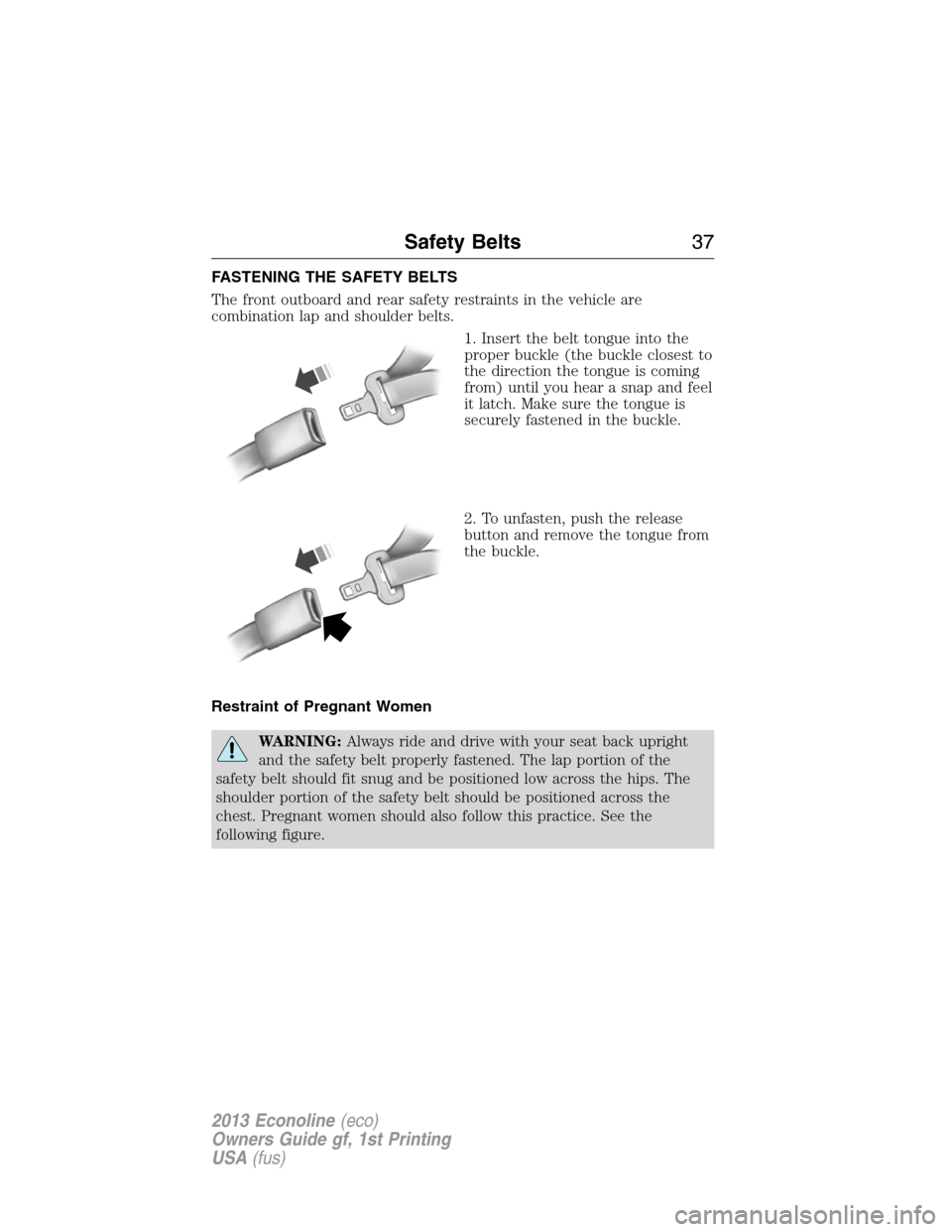
FASTENING THE SAFETY BELTS
The front outboard and rear safety restraints in the vehicle are
combination lap and shoulder belts.
1. Insert the belt tongue into the
proper buckle (the buckle closest to
the direction the tongue is coming
from) until you hear a snap and feel
it latch. Make sure the tongue is
securely fastened in the buckle.
2. To unfasten, push the release
button and remove the tongue from
the buckle.
Restraint of Pregnant Women
WARNING:Always ride and drive with your seat back upright
and the safety belt properly fastened. The lap portion of the
safety belt should fit snug and be positioned low across the hips. The
shoulder portion of the safety belt should be positioned across the
chest. Pregnant women should also follow this practice. See the
following figure.
Safety Belts37
2013 Econoline(eco)
Owners Guide gf, 1st Printing
USA(fus)
Page 38 of 416
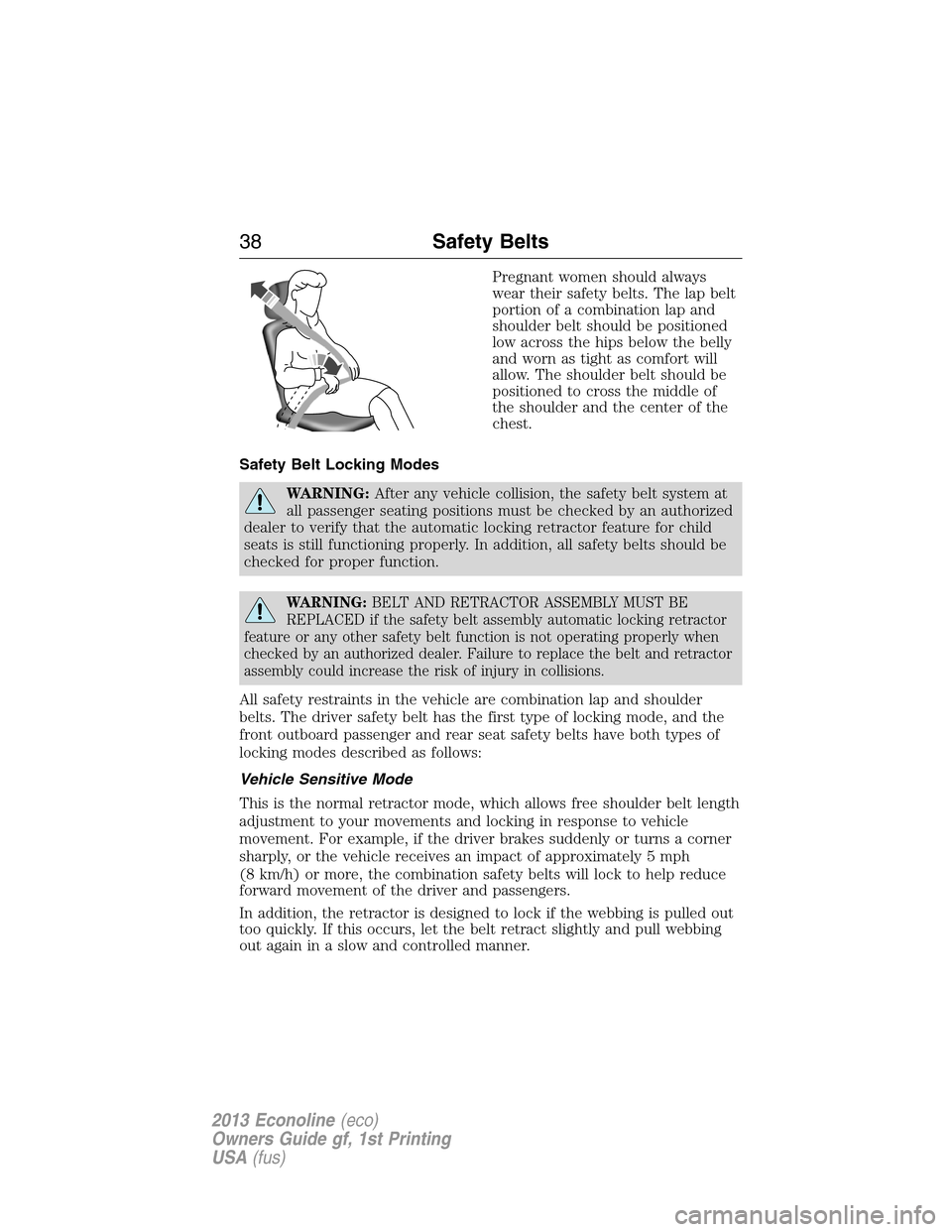
Pregnant women should always
wear their safety belts. The lap belt
portion of a combination lap and
shoulder belt should be positioned
low across the hips below the belly
and worn as tight as comfort will
allow. The shoulder belt should be
positioned to cross the middle of
the shoulder and the center of the
chest.
Safety Belt Locking Modes
WARNING:After any vehicle collision, the safety belt system at
all passenger seating positions must be checked by an authorized
dealer to verify that the automatic locking retractor feature for child
seats is still functioning properly. In addition, all safety belts should be
checked for proper function.
WARNING:BELT AND RETRACTOR ASSEMBLY MUST BE
REPLACED if the safety belt assembly automatic locking retractor
feature or any other safety belt function is not operating properly when
checked by an authorized dealer. Failure to replace the belt and retractor
assembly could increase the risk of injury in collisions.
All safety restraints in the vehicle are combination lap and shoulder
belts. The driver safety belt has the first type of locking mode, and the
front outboard passenger and rear seat safety belts have both types of
locking modes described as follows:
Vehicle Sensitive Mode
This is the normal retractor mode, which allows free shoulder belt length
adjustment to your movements and locking in response to vehicle
movement. For example, if the driver brakes suddenly or turns a corner
sharply, or the vehicle receives an impact of approximately 5 mph
(8 km/h) or more, the combination safety belts will lock to help reduce
forward movement of the driver and passengers.
In addition, the retractor is designed to lock if the webbing is pulled out
too quickly. If this occurs, let the belt retract slightly and pull webbing
out again in a slow and controlled manner.
38Safety Belts
2013 Econoline(eco)
Owners Guide gf, 1st Printing
USA(fus)
Page 39 of 416
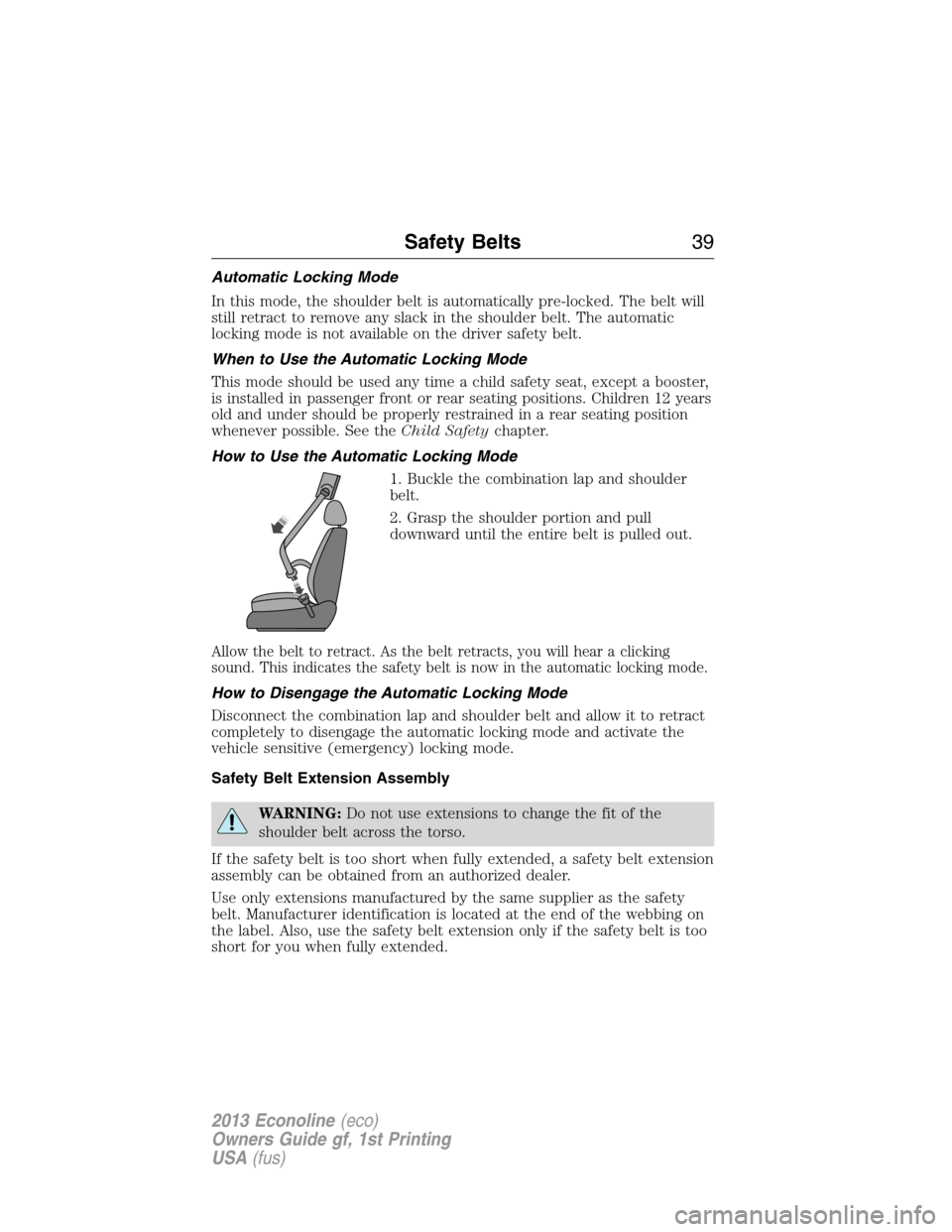
Automatic Locking Mode
In this mode, the shoulder belt is automatically pre-locked. The belt will
still retract to remove any slack in the shoulder belt. The automatic
locking mode is not available on the driver safety belt.
When to Use the Automatic Locking Mode
This mode should be used any time a child safety seat, except a booster,
is installed in passenger front or rear seating positions. Children 12 years
old and under should be properly restrained in a rear seating position
whenever possible. See theChild Safetychapter.
How to Use the Automatic Locking Mode
1. Buckle the combination lap and shoulder
belt.
2. Grasp the shoulder portion and pull
downward until the entire belt is pulled out.
Allow the belt to retract. As the belt retracts, you will hear a clicking
sound. This indicates the safety belt is now in the automatic locking mode.
How to Disengage the Automatic Locking Mode
Disconnect the combination lap and shoulder belt and allow it to retract
completely to disengage the automatic locking mode and activate the
vehicle sensitive (emergency) locking mode.
Safety Belt Extension Assembly
WARNING:Do not use extensions to change the fit of the
shoulder belt across the torso.
If the safety belt is too short when fully extended, a safety belt extension
assembly can be obtained from an authorized dealer.
Use only extensions manufactured by the same supplier as the safety
belt. Manufacturer identification is located at the end of the webbing on
the label. Also, use the safety belt extension only if the safety belt is too
short for you when fully extended.
Safety Belts39
2013 Econoline(eco)
Owners Guide gf, 1st Printing
USA(fus)